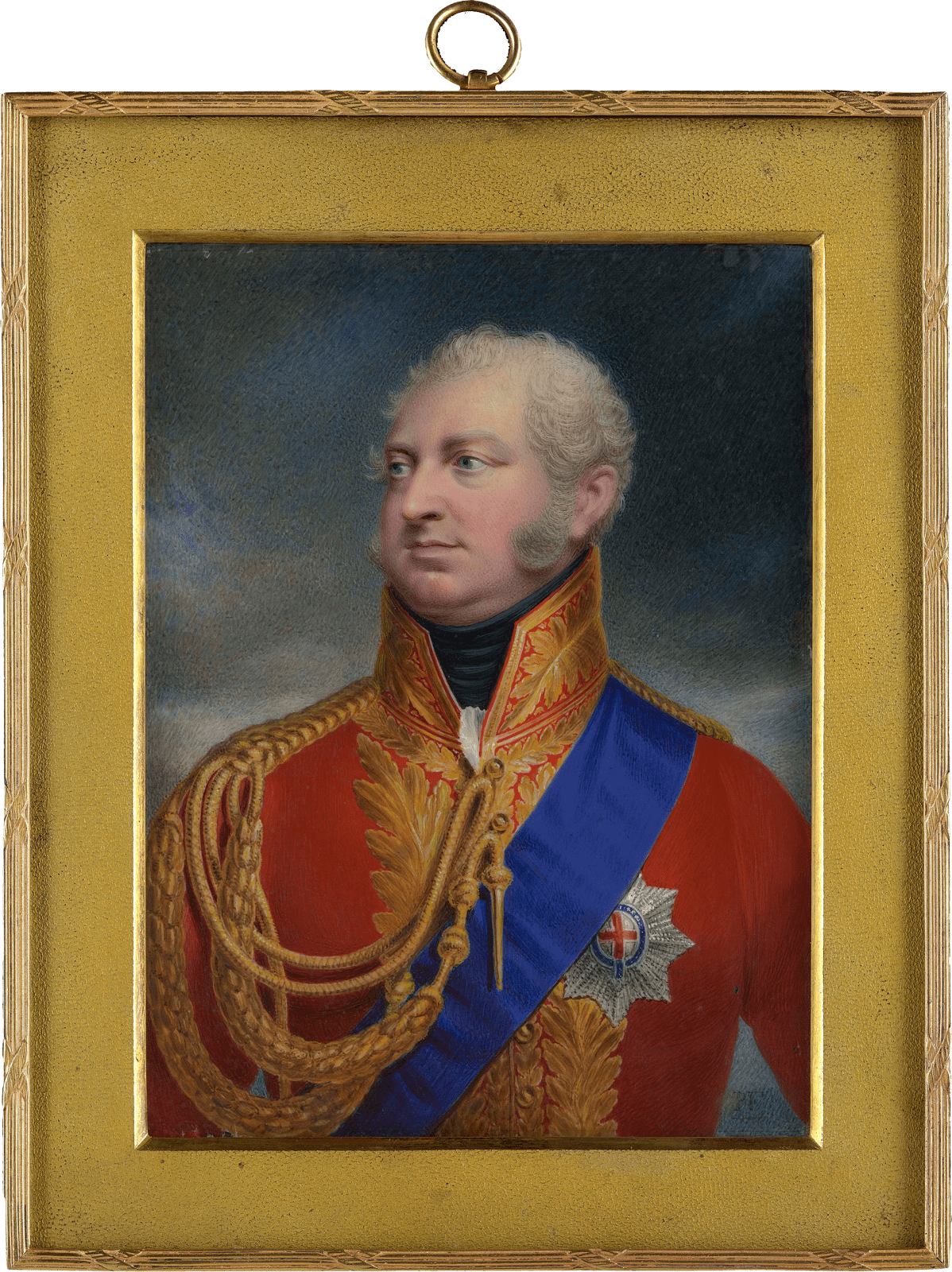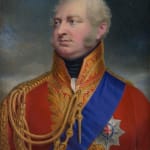

Johann Georg Paul Fischer
To view all current artworks for sale visit philipmould.com
When he arrived in England in 1810, Johann Georg Paul Fischer used his status as a Hanoverian as a means of ingratiating himself with the British royal family, who maintained strong connections with their native Hanover. He executed a number of royal commissions, including the earliest portrait of Queen Victoria, in which she is shown still in her cradle.[1] Three versions of Fischer’s portrait of Frederick, Duke of York, are today housed in the Royal Collection. Only one is, like the present work, on a rectangular support, the other two being oval in format. When they entered the Royal Collection, these portraits were all recorded as having been after William Beechey (1753-1839), presumably via studies relating to Beechey’s group portrait George III at Review (1797-8, destroyed in the 1992 Windsor Castle Fire), in which Frederick features. It may be that Fischer also knew William Skelton’s engraving of the Duke, which was published on 25th October 1812, to which it bears a resemblance. Another, oval version is recorded as having been in the collection of the Dukes of Cumberland in 1914.[2]
As the second, albeit favourite, son of King George III and his wife, Queen Charlotte, Frederick, later Duke of York, was destined for a career in the army. As a youth, he was sent to the family heartlands in Hanover in order to be given exposure to the latest European innovations in military strategy. Having been promoted through the ranks, Frederick returned to England in 1787, where he bought a house in the West Riding of Yorkshire. Frederick soon tired of Yorkshire, however, and sought the excitement of London. Having acquired a reputation as something of a bon viveur, when he sold his house in order to move nearer to London in 1788, rumour abounded that he had lost the property in a game of cards.
This was not by any means the only scandal in which the Duke was entailed. The following year, he fought a duel on Wimbledon Common with Colonel Charles Lennox (later fourth Duke of Richmond). Frederick’s decision to wait until his opponent had fired and then himself fire into the air awarded him a reputation for bravery. But bravery did not translate into tactical acuity on the battlefield. Finding himself in 1793 at the head of the British forces in Flanders against the French Revolutionaries, Frederick proved himself a hapless leader; his military exploits are likely those recorded in the popular nursery rhyme, ‘The Grand Old Duke of York’.
Appointed commander-in-chief of the army in 1798, Frederick made ambitious drives for military reform. But his efforts were undone when, in 1809, the matter of his longstanding affair with Mary Anne Clarke was brought before the House of Commons. Not only, it turned out, had Frederick been unfaithful (a royal predicament to which the British public had become all too inured) but he had also allowed his mistress to take payment from those who were seeking promotion. That same year, Frederick was forced to resign.
The years that followed were quieter. In 1818, on the death of his mother, Queen Charlotte, he was made the official guardian of his father, George, by now crippled with mental illness. Although he had had no children by his wife, Frederica, the eldest daughter of William II, King of Prussia, he looked forward to the day when he might become king, exclaiming at his brother’s coronation ‘By God! I'll have everything the same at mine!’ But, it wasn’t to be as, in 1827, he died, three years before his brother.
[1] V. Remington, ‘Fischer, (Johann Georg) Paul (1786-1875), in Oxford Dictionary of National Biography (Oxford, 2004) [online edn., 2004, accessed 8th July 2019]
[2] V. Remington, Victorian Miniatures in the Collection of Her Majesty the Queen (2 vols., London, 2010), i, pp. 249-251, nos. 479, 480, 481.
When he arrived in England in 1810, Johann Georg Paul Fischer used his status as a Hanoverian as a means of ingratiating himself with the British royal family, who maintained strong connections with their native Hanover. He executed a number of royal commissions, including the earliest portrait of Queen Victoria, in which she is shown still in her cradle.[1] Three versions of Fischer’s portrait of Frederick, Duke of York, are today housed in the Royal Collection. Only one is, like the present work, on a rectangular support, the other two being oval in format. When they entered the Royal Collection, these portraits were all recorded as having been after William Beechey (1753-1839), presumably via studies relating to Beechey’s group portrait George III at Review (1797-8, destroyed in the 1992 Windsor Castle Fire), in which Frederick features. It may be that Fischer also knew William Skelton’s engraving of the Duke, which was published on 25th October 1812, to which it bears a resemblance. Another, oval version is recorded as having been in the collection of the Dukes of Cumberland in 1914.[2]
[1] V. Remington, ‘Fischer, (Johann Georg) Paul (1786-1875), in Oxford Dictionary of National Biography (Oxford, 2004) [online edn., 2004, accessed 8th July 2019]
[2] V. Remington, Victorian Miniatures in the Collection of Her Majesty the Queen (2 vols., London, 2010), i, pp. 249-251, nos. 479, 480, 481.
Provenance
Probably commissioned by Arthur Hill, 3rd Marquess of Downshire (1778-1845), of Ombersley Court, Worcestershire;thence by family descent
- X
- Tumblr
This website uses cookies
This site uses cookies to help make it more useful to you. Please contact us to find out more about our Cookie Policy.
Be the first to hear about our available artworks
* denotes required fields
We will process the personal data you have supplied in accordance with our privacy policy (available on request). You can unsubscribe or change your preferences at any time by clicking the link in our emails.


